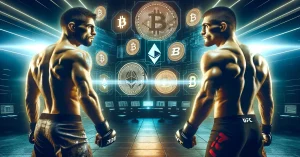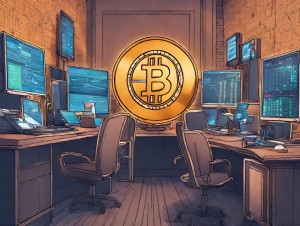The Metaverse has become a popular term among crypto enthusiasts. The idea of creating a digital world where people can own and interact with others ideally has grown significantly; today, even large industries like Meta Platforms have bought into the idea. The Metaverse is continually becoming popular, and more developments are made within the space to test further limits of Web3 technology.
Metaverse coins are simply the currency that people use in the Metaverse. Coin holders can pay for anything within the 3D universe, from avatar clothing to real estate. They can also create and sell products, goods, or services within the platform. And if this is getting baffling, let’s just imagine the things you would do in an alternative reality that you can’t do in real life.
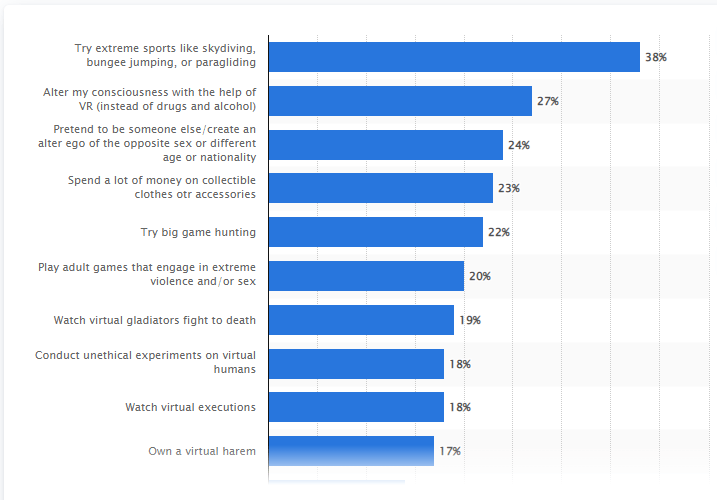
If you now get the picture, you won’t be amazed that people would spend a fortune in Metaverse coins to be able to interact with others in yes, the Metaverse, an alternate universe. What you can imagine, you can become and earn big money, that’s the amazing part. Let’s take the tip from one metaverse connoisseur:
Metaverse is immersive experiences that let you do things with other people, like having fun adventures,
Craig Donato, the chief business officer of modern metaverse poster child, Roblox
In the current crypto market, several Metaverse coins are listed, and in this guide, we will discuss the top metaverse coins by market cap.
Metaverse Coins List
Metaverse coins, digital assets tailor-made for the virtual realm, are the linchpin of this emerging digital frontier. Their primary role as the Metaverse’s native currency facilitates transactions, ownership, and interactions, setting the stage for a dynamic virtual universe. In essence, these coins are the building blocks of the Metaverse, empowering users to buy virtual real estate, acquire digital goods, and partake in immersive virtual experiences.
Their significance stems from their versatility and utility, providing a secure and seamless means of exchange within a decentralized environment. As the Metaverse expands, these coins assume a pivotal role in shaping its economy and ensuring its interconnected vitality. This introduction elucidates the vital role of Metaverse coins, setting the stage for a deeper exploration of their selection criteria, top contenders, investment considerations, and potential rewards.
Understanding Metaverse Coins
Metaverse coins, a cornerstone of the digital landscape, are digital assets specifically designed for use within the Metaverse. Their significance within this virtual realm cannot be overstated. These coins are the lifeblood of the Metaverse, facilitating transactions, ownership, and interactions within this digital universe.
In simple terms, Metaverse coins act as the native currency of this virtual world. They enable users to buy virtual real estate, purchase digital goods, and participate in virtual experiences. These coins are essential for building, trading, and engaging within the Metaverse ecosystem.
Their importance lies in their versatility and utility. Metaverse coins offer a seamless and secure means of exchange within a decentralized environment. They empower users to take control of their digital assets and navigate this digital frontier with ease.
As the Metaverse continues to grow and evolve, these coins play a pivotal role in shaping its economy and ensuring a vibrant and interconnected virtual universe. Understanding the significance of Metaverse coins is crucial for anyone looking to explore, invest in, or participate in this exciting digital landscape.
Criteria for Selecting Metaverse Coins
Selecting Metaverse coins for the list involves a careful evaluation of several key criteria, ensuring that the chosen coins truly represent the best options within this digital realm.
Market Capitalization: Market capitalization is a fundamental factor in determining a coin’s prominence within the Metaverse. Coins with substantial market capitalization tend to have more significant adoption, liquidity, and stability. As a result, coins with a higher market cap are often prioritized for inclusion.
Performance: The performance of a Metaverse coin is a critical consideration. This includes both short-term and long-term performance metrics. Factors such as price trends, trading volume, and historical growth patterns are examined to gauge a coin’s reliability and potential for sustained success.
Relevance to the Metaverse: Relevance is a key factor in selecting Metaverse coins. Coins that actively contribute to the Metaverse ecosystem by enabling transactions, powering decentralized applications (DApps), or fostering community engagement are highly regarded. Their role and impact within the Metaverse play a significant role in their selection.
Community Support: The strength of the coin’s community is another essential aspect. A thriving and engaged community often indicates a coin’s potential for growth and resilience. It can contribute to broader adoption and the development of a robust Metaverse ecosystem.
Technology and Innovation: The underlying technology and innovative features of a coin are evaluated. Coins that offer unique capabilities, security enhancements, or scalability solutions may be given preference.
Regulatory Compliance: Compliance with relevant regulations is vital. Coins that adhere to regulatory guidelines and maintain transparency in their operations are more likely to be included in the list.
Overall Contribution: The overall contribution of a coin to the Metaverse’s functionality and utility is assessed. Coins that enhance user experiences, facilitate virtual property ownership, or enable cross-platform interactions hold a significant place in the list.
By considering these criteria, the selection process aims to identify Metaverse coins that are not only successful in the crypto market but also actively shape the landscape of the Metaverse, providing users with a seamless and rewarding digital experience.
Top 5 Metaverse Coins
In the ever-expanding realm of the Metaverse, certain cryptocurrencies have emerged as frontrunners, commanding attention and investor interest. Here, we present a concise list of the top 5 Metaverse coins based on their market capitalization, offering key insights into each of them.
Axie Infinity (AXS)

Overview: Axie Infinity, often referred to as AXS, stands as a pioneering force within the Metaverse. It plays a pivotal role in enabling play-to-earn gaming experiences, allowing users to own, trade, and battle cute creatures called Axies.
Axie Infinity is a unique blockchain project that incorporates the unique selling points of blockchain and Web3 technology. The platform allows users to interact by trading, collecting, raising, battling, and breeding token-based creatures, known as Axies. Several variations of the Axies with several body parts contribute to a wide variety of options available on the platform.
The Axies are considered NFTs with unique features that cannot be replicated. The creatures can be bred to give rise to unique creatures with different features. The potential is essentially limitless. The Axie Infinity platform, therefore, has a governance system.
The AXS is the governance token for the Axie Infinity platform. The AXS is short for Axie Infinity Shards. By holding the AXS token, you get the privilege to determine the organization’s direction through a voting system.
Unique Features: Axie Infinity’s unique approach to combining blockchain technology with gaming has created a vibrant ecosystem where players can earn rewards by participating in battles and various in-game activities.
Recent Developments: The game’s popularity has surged, attracting a global player base, and the AXS token has seen impressive growth in value.
The Sandbox (SAND)
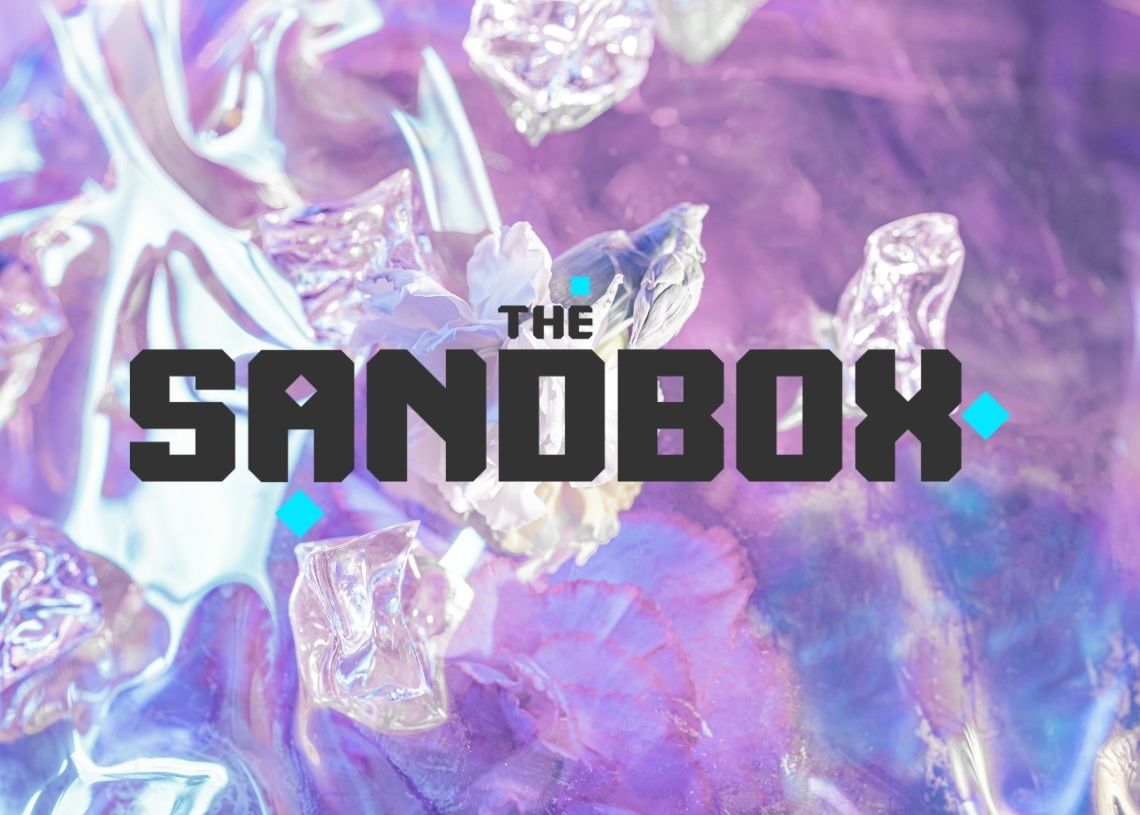
Overview: The Sandbox, represented by the SAND token, is a Metaverse platform that empowers users to create, own, and monetize their gaming experiences and assets in a decentralized virtual world.
The Sandbox platform was launched in 20211 by Pixowl. The platform extensively explores Web3 possibilities as it encourages developing, creating, and selling digital assets on its platform. Since then, Sandbox has continued to improve its platform to ensure sustainability and efficiency for its users. The Sandbox platform focuses on the gaming community by incorporating the power utilities of the Decentralized Autonomous Organizations and Non-Fungible Tokens.
The Sandbox’s primary focus on the gaming platform aims to introduce the unique features of blockchain technology to online gaming. The efforts have been somewhat successful up to date, as witnessed by the stellar performance of its native crypto token, SAND.
Significance: It fosters creativity and collaboration within the Metaverse, allowing users to design and trade their virtual creations.
Partnerships: The Sandbox has established strategic partnerships with major brands and IP holders to expand its virtual universe, making it a compelling Metaverse contender.
Theta (THETA)

Overview: Theta, symbolized as THETA, introduces innovative solutions to the Metaverse, focusing on decentralized video streaming and content delivery.
The Theta Network is a revolutionary blockchain project that aims to disrupt the video streaming industry. The Theta Network benefits from the advice of two industry-proven professionals, Steve Cheng and Justin Kan, who are Youtube Co-founder and Twitch co-founders, respectively.
The ability to associate themselves with verifiable and credible industry professionals boost their credibility. The platform has its own native cryptocurrency, known as THETA. Theta is primarily used to run governance tasks around the Theta metaverse ecosystem.
The Theta metaverse crypto coin has performed well since its launch. The token has, however, experienced price declines within the past few days due to the overall bear sentiment on metaverse crypto in general.
Market Performance: THETA has shown consistent growth in the crypto market, gaining traction as a Metaverse coin with immense potential.
Metaverse Contribution: By improving streaming efficiency and incentivizing content creators, Theta contributes significantly to the Metaverse’s content-rich environment.
Decentraland (MANA)

Overview: Decentraland, powered by the MANA token, is a virtual world where users can purchase, build, and trade on parcels of land.
Decentraland is one of the popular Metaverse platforms. The Decentraland is a virtual reality platform that runs on the Ethereum ecosystem. The popularity of Decentraland rose with the increasing attention given to Metaverse tokens. The Decentraland platform essentially used two tokens, namely the MANA and LAND. MANA is an ERC-20 token, while LAND is a non-fungible ERC-721 token. The two tokens are essential for the success of the Decentraland project.
The Decentraland platform allows creatives to create and monetize content on the platform. Using the MANA token, users can purchase LAND in the form of NFTs and develop them on the Decentraland platform. The platform is limitless and continues exploring all the Web3 possibilities, implying a brighter future for the MANA token and the Decentraland platform.
Role in the Metaverse: It serves as a virtual space for creative expression, gaming, and social interaction, making it an integral part of the Metaverse ecosystem.
Recent Developments: Decentraland continually evolves, with users building diverse experiences and businesses on its decentralized platform.
ApeCoin
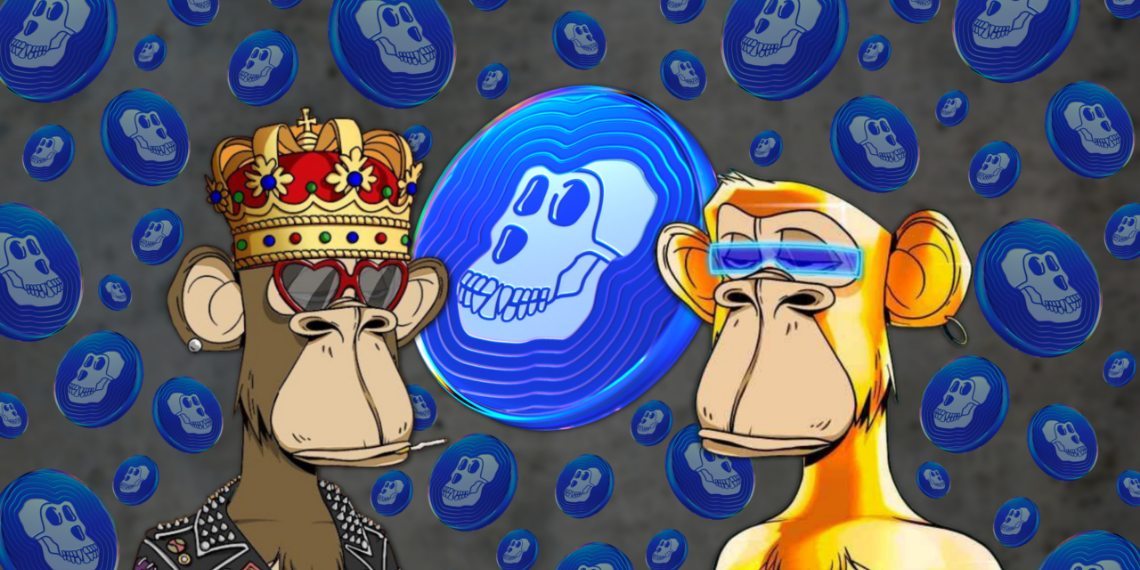
Overview: ApeCoin is a rising star in the Metaverse, gaining attention for its unique contributions.
ApeCoin is the native token used for governance and utility purposes within the APE ecosystem. Following the sensational Bored Ape Yacht Club project, the APE ecosystem has made significant strides to propel the Metaverse concept to greater heights. The Yuga Labs’ success with the Bored Ape Yacht club has spilled over to the ApeCoin, a metaverse token designed to allow the governance of the APE ecosystem. The ApeCoin is a means to govern the ApeCoin DAO Ecosystem Fund by determining how the funds should be used. The voting rights are obtained by holding ApeCoin tokens, which are ERC-20 governance tokens within the APE ecosystem.
ApeCoin was inspired by the Yuga Lab’s Bored Ape Yacht Club project, which has received attention from several celebrities on the internet. The ownership of Apecoin allows developers to interact with the platform and incorporate ApeCoin into services and games.
Metaverse Role: ApeCoin’s role in the Metaverse may vary, from enhancing gaming experiences to enabling cross-platform interactions.
Innovation: Recent developments and innovations surrounding ApeCoin are positioning it as a promising contender within the evolving Metaverse landscape.
These top Metaverse coins are instrumental in shaping the digital future, offering diverse experiences and opportunities within the virtual realm.
Investment Considerations
For investors intrigued by the potential of Metaverse coins, there are several crucial factors to consider, along with associated risks and rewards.
Market Volatility
Consideration: The cryptocurrency market, including Metaverse coins, is known for its high volatility. Prices can fluctuate significantly within short periods.
Risk: Investors should be prepared for price swings and potential losses if they decide to enter this market.
Reward: Volatility can also mean substantial gains for those who time their investments wisely.
Research and Due Diligence
Consideration: Thoroughly research the coins you intend to invest in. Understand their use cases, teams, and long-term potential.
Risk: Neglecting research can lead to investment in coins with no real utility or questionable backgrounds.
Reward: Informed investors can identify promising projects with genuine Metaverse contributions.
Diversification
Consideration: Diversify your cryptocurrency portfolio. Don’t put all your funds into a single coin.
Risk: Overconcentration in one coin amplifies the impact of its price movements.
Reward: Diversification helps spread risk and potential rewards across different assets.
Security
Consideration: Ensure you store your Metaverse coins securely in a reputable wallet.
Risk: Inadequate security measures can result in theft or loss of your assets.
Reward: Proper security safeguards your investments from external threats.
Long-Term vs. Short-Term
Consideration: Define your investment horizon—short-term trading or long-term holding.
Risk: Short-term trading can be more speculative and riskier, while long-term holding requires patience.
Reward: Long-term investors may benefit from potential coin growth over time.
Investing in Metaverse coins offers exciting opportunities but comes with inherent risks. Diligence, diversification, and a clear investment strategy can help mitigate these risks and position investors to potentially benefit from the growth of the Metaverse. Always consult with a financial advisor before making investment decisions.
Potential rewards for investors in Metaverse coins
Long-Term Growth
Many Metaverse coins have demonstrated impressive long-term growth potential. As the Metaverse concept gains popularity and virtual worlds expand, these coins can increase in value significantly over time.
Early Investment Opportunities
Investing in Metaverse projects during their early stages can offer substantial rewards. Early investors often have the chance to acquire tokens at a lower cost, potentially benefiting from significant price appreciation as the project evolves.
Community Engagement
Coins with active and engaged communities tend to perform well. A strong community can drive adoption, development, and partnerships, positively impacting the coin’s value.
Innovative Features
Some Metaverse coins offer innovative features and use cases that make them attractive to users and investors. These unique functionalities can contribute to increased demand and value.
Diversification
Metaverse coins provide diversification opportunities for investors. Diversifying a portfolio by including Metaverse assets can help spread risk and potentially lead to more balanced and profitable investments.
Investors should exercise caution, conduct thorough research, and be aware of the risks associated with cryptocurrency investments. While these potential rewards exist, the crypto market can be volatile, and outcomes may vary.
Other Metaverse Projects
Enjin Coin (ENJ)
The Enjin Coin is part of the Enjin ecosystem, a project that provides blockchain-based solutions to the online gaming industry. The parent Enjin network is a robust blockchain network platform that allows users to create clans and websites. The interaction with the social gaming platform allows users to host virtual items on the platform.
The platform allows the developers to tokenize the digital assets within the virtual world. The continued buying and selling of these digital assets increase the overall activity of the platform, becoming beneficial to both ENJ metaverse coin holders and developers on the Enjin network.
The creators and users of the Enjin network platform can take advantage of the anti-inflationary policy of the network. Similarly, the platform provides instant liquidity and reserve values that are huge incentives for the Metaverse projects.
Stacks (STX)
Stacks is an innovative layer 1 blockchain project aiming to uplift Bitcoin’s technical potential. Layer 2 blockchain projects addressed several limitations to the Bitcoin network. The Stacks projects seek to enable the Bitcoin network to utilize smart contracts and other decentralized applications (DApps) capabilities.
Essentially the technology allows developers to create other projects on other projects, allowing the Decentralized apps to be open and modular for improvements and further developments, a feature that inherently lacks on a typical Bitcoin network. The platform benefits from the security of the Bitcoin blockchain, which is arguably the most secure blockchain network to date.
The Stacks platform aims to enhance the abilities of the blockchain network by fueling the execution of smart contracts. Similarly, the platform facilitates the registration of new digital assets and efficient transaction processing on the Stacks 2.0 blockchain.
Zilliqa (ZIL)
The Zilliqa platform is a unique blockchain platform that is well known for its ability to complete multiple transactions faster per second. The platform brings efficiency to the blockchain world with its ability to complete thousands of transactions in seconds. Also, it is reportedly the first public and permissionless blockchain to depend entirely on a shared blockchain network.
The Zilliqa project was founded by Prateek Saxena, a university assistant professor in Singapore. Prateek and his students determined that sharding on a blockchain could significantly increase the speed and efficiency of the network, a concept that led to the birth of Zilliqa.
Today, the Zilliqa platform achieves impressive throughput as required. The platform’s ability to process several transactions per second allows it to be a blockchain of choice for large enterprises. The blockchain solution has proven to be extremely instrumental in providing efficient services to industries, including but not limited to advertising, financial services, and entertainment. The platform had achieved more than one million transactions per month by 2021.
Wax (WAXP)
WAX is an e-commerce focussed blockchain technology that is developed to improve the efficiency of transactions within the e-commerce space. The blockchain ecosystem allows for faster transactions between vendors and buyers. The WAX is completely compatible with Entrepreneurial Operating System (EOS), making it extremely scalable and applicable in several instances within the e-commerce space.
Additionally, the WAX platform operates under the DPoS, a consensus mechanism known as delegated proof of stake. The ecosystem allows for innovative developments within the e-commerce sector by encouraging the development of its blockchain tools that support the DApps.
The WAX ecosystem has developed several utilities for the e-commerce platforms, such as the incorporation of WAX Cloud Wallet and OUTH support for e-commerce platforms. The innovative platform also has a provision to allow WAXP holders to convert to an ERC-20 friendly WAXP token version known as WAXE. by bridging to the Ethereum network.
Ontology (ONT)
Ontology is a Web3 project that is developed to strengthen the privacy, security, and trust of Web3 technology. The web 3 project plans to incorporate decentralization in data handling to ensure the safety and privacy of Web 3 projects. Ontology ensures that digital identity data is regulated to ensure trust from enterprises and individuals. The platform demands compliance from all parties to ensure frictionless handling of digital identification.
The Ontology platform has seamless compatibility with the Ethereum blockchain through the Ontology’s Ethereum Virtual Machine ensures interoperability across several blockchains. The platform allows for seamless integration of the virtual and physical worlds, allowing more specific developments within its platform.
One major challenge faced by Web3 developers is interoperability which in turn thwarts scalability. Ontology plans to bridge these gaps and allow Web3 developers to experience smooth development processes across multiple virtual machines and blockchains in general. The success of Ontology will directly translate to the positive growth of the ONT metaverse coin that is native to the platform.
PlayDapp (PLA)
PlayDapp is a blockchain platform that is focused on digital gaming. The PLA token is the native token of the PlayDapp gaming blockchain that allows players to buy and sell digital assets within the Metaverse.
Metaverse crypto such as the PLA have a bright future due to the utility provided by their native platforms. The PlayDapp blockchain metaverse project targets to make blockchain gaming more accessible and mainstream. The platform essentially converts regular environment games to metaverse games on its platform.
The players can then interact with the Metaverse coin, PLA, within the virtual world through augmented reality technology. The Metaverse coins are poised to grow as more players adopt the PlayDapp platform and the demand for PLA tokens increases. The platforms are currently on track to partner with more metaverse game developers to increase activity within the platform.
The PLA token is used to purchase in-game items. The token can also be used to purchase a variety of NFT assets within the PlayDapp ecosystem. It currently trades on Binance, Phemex, and MEXC crypto exchange platforms.
SushiSwap (SUSHI)
SushiSwap is an Automated Market Maker (AMM) which depends on an elaborate mathematical formula to price digital assets. The Sushiswap is a popular decentralized exchange platform that automates the pricing between two digital assets on its platform based on the difference between liquidity.
The Sushiswap platform allows profits from the transactions made on its platform as it reportedly holds 0.3% of the transaction fees. The platform thrives among DeFi fans as it profits from liquidity providers looking to take advantage of DeFi projects that have recently experienced an influx of investors.
Sushiswap is forked from Uniswap and intended to increase user involvement compared to Uniswap. The token, SUSHI, is used as a reward system on the platform. Additionally, the SUSHI coin is used for governance purposes within the platform. The SUSHI token is freely traded and can be found on multiple crypto exchange platforms around the globe.
Render Token (RNDR)
The RNDR, as the name suggests, is distributed rendering platform for GPUs. The idea is to bridge the gap between artists and creatives who struggle to access the required GPU power when going about their businesses. The RNDR creates a platform that allows for sharing GPU computing power with the creatives using its platform. The RNDR token is an ERC 20 token that operates on the platform.
Ideally, the RNDR token is comprised of elaborate proof of work automatic and mechanical systems. The artists can access the shared GPU computing power by paying using the RNDR token. The RNDR advisory board consists of renowned industry payers who increase the credibility of the platform’s future growth.
CEEK VR (CEEK)
CEEK is a metaverse project that allows creators and artists to connect with their fans. The metaverse project provides unique experiences for both digital art creators and advertisers on the platform. Essentially, it gives an additional income opportunity for digital creators.
The CEEK virtual reality can be accessed through their website or by using customer Virtual reality headsets. The experience allows fans to attend live events with their friends to support the artist of their choice. The activity on the platform is monitored closely, allowing advertising agencies to analyze traffic activity for advertising purposes.
The CEEK VR token, known as CEEK, has benefited from partnerships with big industry players like Apple, Microsoft, and Universal music. The partnerships will propel the token to achieve its mission of creating an accessible decentralized virtual reality platform to become one of the best metaverse ecosystems.
Ultra (UOS)
The Ultra platform is an ecosystem that promotes video gaming and other video game content. The Ultra platform aims to open up the video publishing industry to all game developers and allow for free publishing, liberating many developers from the monopoly of big game publishing ecosystems like Steam.
The Ultra platform provides an extensive marketing strategy with tools that equip game developers to be ready to hit the ground running. The platform has successfully built a platform that promotes PC game publishing that apparently outshines the existing gaming platforms in the market.
Ultra provides an elaborate reward system for all participants making it useful and lucrative for all users. The platform allows game developers to earn 21% more and receive payments faster than other conventional game publishing platforms. The players also have an option to earn money by interacting with the platform through advertisements and game curations.
Reef (REEF)
The Reef ecosystem is a first layer 1 blockchain that brings together DeFi, NFT, and Gaming. The ecosystem runs on the substrate framework that allows for massive scalability- a major challenge for many blockchain systems.
The Reef Chain is arguable the most efficient and advanced chain that is perfectly compatible with Ethereum Virtual Machine. The interoperability it provides allows for token bridges as it continues to develop and support other virtual machines.
The REEF token is the native digital token of the Reef ecosystem that runs under the nominated Proof of Stake consensus mechanism. Essentially the token is used to run validator nodes through staking. Similarly, the REEF coin is used to pay the fees for storing the data as well as processing the transactions within the ecosystem.
XYO (XYO)
The XYO is a technology protocol that is designed to improve the validity, certainty, and value of data. The platform claims to build a robust data marketplace that allows users to interact with verifiable data.
The XYO network currently has over 5 million nodes and claims the platform is to be the first reality oracle. XYO aims to increase the trust for data within web 3 platforms and provides absolute ownership of data to their owners. The innovative data management project XYO comes at a time when the world is shifting to big data, and decisions are essentially data-driven.
Chromia (CHR)
Chromia is a public blockchain that is open source and public and was conceived by Chromaway AB. It is a layer 1 blockchain but also compatible with EVM layer 2 and Binance smart chain. The project enhances blockchain capabilities by allowing more scalable decentralized applications to be built upon it.
The Chromia has several decentralized applications already built on its platform, and the layer 2 platform pushes for the development of Dapps in a unique and scalable way. Every decentralized application on Chromia is designed to run on its own sidechain, with a link to Chromia’s mainchain to allow for scalability.
The flexibility the Chromia platform provides promotes innovative developers to continue exploring the endless possibilities of Web3 technology while also improving data handling.
WEMIX (WEMIX)
The blockchain-based solution aims to provide a metaverse gaming solution with minimal gas fees and high transaction speeds. High gas fees and slow speeds have been serious hindrances to blockchain solutions across the spectrum, from gaming to financial services.
The WEMIX platform aims to massive recruitment of conventional gamers into its platform. There are currently over 1 billion online gamers worldwide, so the platform seeks to provide its users with a simple, easy-to-use platform that utilizes Web 3 technology. The idea is to bring simplicity to gaming as a unique selling point, challenging other metaverse projects that are overly complicated and somewhat expensive.
RadioCaca (RACA)
The RadioCaca metaverse and virtual worlds were introduced in 2021 as the RACA NFT marketplace. After the launch, the platform underwent rigorous positive growth, which saw the platform recorded a trading volume of about $1.3 billion in April 2022. Due to its innovative NFT collection, vibrant community, and general social media presence, the token has continued to grow as the platform enlarges. It is compatible with both the BNB chain and Ethereum.
Conclusion
Metaverse coins have emerged as a crucial component of the rapidly growing Metaverse ecosystem. These digital assets play a pivotal role in enabling virtual experiences, transactions, and interactions within the Metaverse. With the Metaverse gaining increasing attention, the significance of these coins cannot be understated.
Investors looking to explore the world of Metaverse coins should consider factors such as market capitalization, performance metrics, relevance to the Metaverse, community support, technology and innovation, regulatory compliance, and overall contribution to the digital realm. These criteria help identify coins that not only excel in the crypto market but also actively shape the Metaverse landscape.
It is important to approach Metaverse coin investments with diligence and conduct thorough research. While the potential rewards are enticing, the crypto market’s volatility demands informed decision-making. Staying updated on market trends and developments is crucial for making sound investment choices.
Metaverse coins represent an exciting opportunity for investors to participate in the evolution of the Metaverse. By staying informed and making informed decisions, individuals can potentially benefit from the growth of this innovative digital space.


